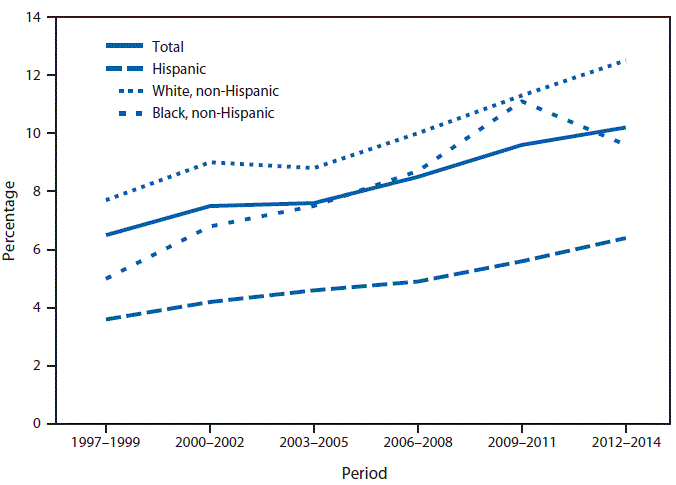QuickStats: Percentage of Children and Adolescents Aged 5–17 Years with Diagnosed Attention-Deficit/Hyperactivity Disorder (ADHD),* by Race and Hispanic Ethnicity — National Health Interview Survey,† United States, 1997–2014

* Based on responses to the question, "Has a doctor or health professional ever told you that (child) had attention-deficit/hyperactivity disorder (ADHD) or attention deficit disorder (ADD)?"
† Estimates are based on household interviews of a sample of the civilian noninstitutionalized U.S. population and are derived from the National Health Interview Survey's Sample Child component.
From 1997–1999 to 2012–2014, the percentage of all children aged 5–17 years with diagnosed attention-deficit/hyperactivity disorder (ADHD) increased significantly from 7.0% to 10.2%, and so did the prevalence among non-Hispanic white children (8.4% to 12.5%), non-Hispanic black children (5.5% to 9.6%), and Hispanic children (3.8% to 6.4%). Throughout 1997–2014, Hispanic children were the least likely to have diagnosed ADHD.
Source: National Center for Health Statistics, CDC. National Health Interview Survey. Available at http://www.cdc.gov/nchs/nhis.htm.
Reported by: Patricia Pastor, PhD, ppastor@cdc.gov, 301-458-4422; Catherine Duran; Cynthia Reuben, MA.
Alternate Text: The figure above is a line chart showing that from 1997-1999 to 2012-2014, the percentage of all children aged 5-17 years with diagnosed attention-deficit/hyperactivity disorder (ADHD) increased significantly from 7.0% to 10.2%, and so did the prevalence among non-Hispanic white children (8.4% to 12.5%), non-Hispanic black children (5.5% to 9.6%), and Hispanic children (3.8% to 6.4%). Throughout 1997-2014, Hispanic children were the least likely to have diagnosed ADHD.
Use of trade names and commercial sources is for identification only and does not imply endorsement by the U.S. Department of
Health and Human Services.
References to non-CDC sites on the Internet are
provided as a service to MMWR readers and do not constitute or imply
endorsement of these organizations or their programs by CDC or the U.S.
Department of Health and Human Services. CDC is not responsible for the content
of pages found at these sites. URL addresses listed in MMWR were current as of
the date of publication.
All MMWR HTML versions of articles are electronic conversions from typeset documents.
This conversion might result in character translation or format errors in the HTML version.
Users are referred to the electronic PDF version (http://www.cdc.gov/mmwr)
and/or the original MMWR paper copy for printable versions of official text, figures, and tables.
An original paper copy of this issue can be obtained from the Superintendent of Documents, U.S.
Government Printing Office (GPO), Washington, DC 20402-9371;
telephone: (202) 512-1800. Contact GPO for current prices.
**Questions or messages regarding errors in formatting should be addressed to
mmwrq@cdc.gov.


